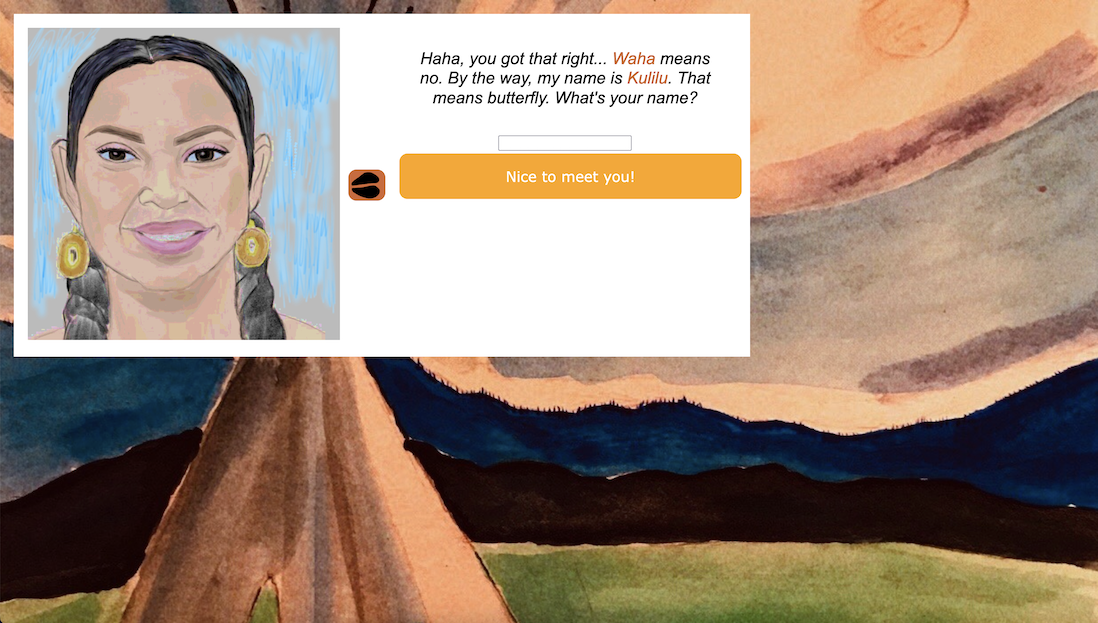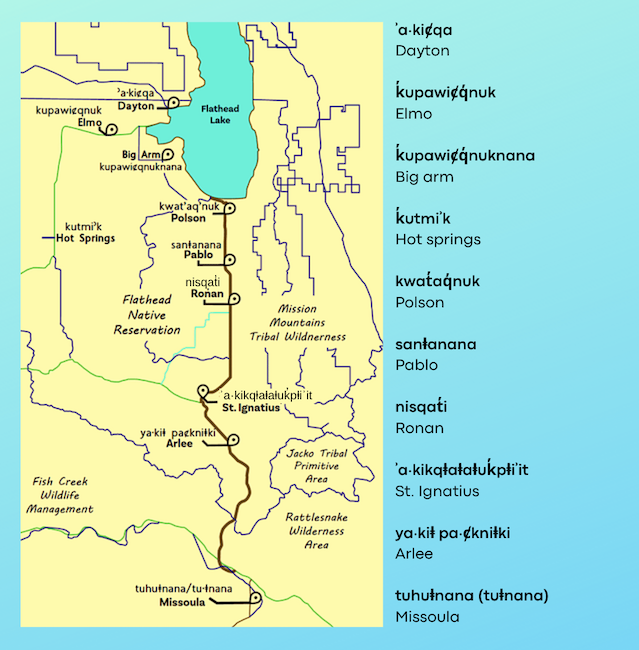Welcome to the Ktunaxa Interactive Language Learning project!
WATCH OUR VIDEO!
This is a Ksanka-led project with the goal to develop the first interactive language learning adventure game for Ktunaxa.
Skinkuȼ ȼ Kulilu (Coyote and Butterfly) is a make-your-own-adventure game with audio and images in which the player makes important choices that drive the story forward.
The story is set on the Flathead Reservation in and around Kwat̓aq̓nuk (Polson) and K̓upawiȼq̓nuk (Elmo).
You play a young person who just finished high school and visits their aunty for the summer, preparing to go to SKC (Sanⱡanana-Ksanka-College, a fictional college in the game, based on the real-world Salish-Kootenai-College).
Then you meet Skinkuȼ and Kulilu and the adventures begin...
HOW THE GAME WORKS
The player moves through the game by makíng choices (multiple choice) or providing text input (text boxes).
You can...
- Talk with other characters in the game to learn about the place, make friends, and pick up language skills.
- Unlock new words and phrases on your way.
- Make decisions about what to say, where to go, and what to do. (Score respect points for culturally appropriate choices!)
- Solve mini-puzzles to unlock new paths and important knowledge (and practice your language skills in the process!).
Access the game here (currently under review!):
Kⱡinq̓uⱡan! (Play it!)
Note: Currently, the game is using the writing convention of the Ksanka band of the Ktunaxa tribe.
We are happy to add additional versions to reflect the dialect and writing systems of other Ktunaxa bands.
Please get in touch!
HOW LANGUAGE LEARNING IS SUPPORTED BY THE GAME
#game-based_learning
Learners get to apply language content in SIMULATED CONVERSATIONS and contexts with real-world relevance.
The focus lies on EVERYDAY LANGUAGE SKILLS.
Learning happens in a FICTIONAL world, a SAFE SPACE where errors are allowed while making progress towards learning goals.
#contextualized_content
Rather than memorizing isolated words from word lists, learners can practice words and phrases in the CONTEXT in which they would naturally occur in everyday situations.
#scaffolded_immersion
To make sure not to overwhelm learners with too much content, the game relies on English as a SHARED LANGUAGE and introduces Ktunaxa concepts, words and phrases STEP BY STEP.
Once a concept is introduced in Ktunaxa, it will stay in the language from then on, working towards full IMMERSION.
Words and phrases are explained and often broken down into their COMPONENTS (morphological analysis) to provide a SCAFFOLD for learners to understand fully what they are learning and to support their pattern recognition.
#spaced_repetition
Ktunaxa concepts are REPEATED FREQUENTLY and in REGULAR INTERVALS throughout the game, and they re-surface in various CONVERSATIONAL SITUATIONS to demonstrate the range of contexts in which a word or phrase can be used.
#audio_visual_support
The language content is supported by GRAPHIC ILLUSTRATIONS and AUDIO RECORDINGS are integrated for Ktunaxa words and phrases.
#feedback
DIRECT FEEDBACK is provided to learners either EXPLICITLY by a direct comment on a conversational choice they made in the game, or IMPLICITLY by a game character's reaction to something the player chose to say.
#learner_motivation
The game motivates players with a FUN MISSION to solve, and offers CULTURAL GUIDANCE alongside the language practice.
#learner_agency
The game puts the learner in charge: they decide WHEN AND WHERE they want to practice their skills, what they want to repeat and what to focus on, based on their own learning goals.
#learning_while_designing
The process of developing the game offers great benefits in itself: While working on the game, language learners, speakers and teachers can team up to design the game chapters and missions.
During this COLLABORATION, learners engage naturally with the language.
When designing the language curriculum and the learning experience for the game, learners take on the perspecitve of a teacher, and explore the language content on a deeper level.
Our team has found that we naturally pick up LANGUAGE KNOWLEDGE while working on the game.
Plus, we have a lot of FUN!
Ȼ̓ikan! (Come!) Join us! Get in touch
CO-DESIGN
The project team consists of Ktunaxa community members and their non-Ktunaxa colleagues who all bring different kinds of expertise to this project,
e.g. story-telling, arts & design, instructional design, youth advocacy, tech implementation etc. We meet regularly and share the decision-making for all aspects of this project,
including the curriculum design, story and game development, governance, engagement with learners and project promotion, etc.
COMMUNITY OWNERSHIP
All language content and cultural heritage that we implement in the game is owned by the Ktunaxa language community. It is only made available to Ktunaxa
language learners for educational purposes. We work closely with the Elders Meeting in Elmo, and the Tribal Council of the Confederated Salish and Kootenai
Tribes to make sure the content is correct and appropriate, and can be shared with Ktunaxa language learners in the context of this game.
SUSTAINABLE RESOURCES
The project relies on accessible open source / free software and basic formats that are long-lived to make sure the game is sustainable.
The project team trains their capacity to work with these tools to make updates to the content and add further chapters to the game independently.
We offer community-oriented workshops to introduce the tools and workflows. Reach out if you are interested in learning more!
EMPOWERING LEARNERS
The project emphasises the learner perspective, and we aim to implement features to help learners be in charge of their own learning process,
such as practice mechanisms with integrated feedback, keeping track of learned content, grammatical information on demand, and a motivating learning experience
that learners can engage with in their own time.
SUPPORT & FUNDING
We work with the approval of the Tribal Council of the Confederated Salish and Kootenai Tribes. The team consults with the Elders Meeting in Elmo and fluent speakers and teachers
of Ktunaxa for their advice on the language and cultural content for the game.
The team was awarded a Native Voices Endowment grant from the Endangered Language Fund twice, once in 2020, and again in 2022.
We are grateful for the support we receive for this project!
Hu sukiⱡq̓uknaⱡa'ni! (We are glad / thankful!)
Ȼi·katin! (literally: Look at it!)
SNAPSHOTS FROM THE GAME
Click on the images to make them larger!
INFO POSTER
The team presented this at the International Conference on Language Documentation & Conservation (ICLDC) in 2021.
Scroll up and down to see all three poster pages! You can also zoom in and out, and download the poster.
AND...LANGUAGE STICKERS!!!
The awesome game art by our in-house illustrator Rich Brisbois inspired us to create a series of Ktunaxa language stickers...
Click on the images for more info!
You would like a sticker? Or, you have an idea for a sticker? Hu ȼⱡakiⱡnaⱡaʾni! (We like it!)
We'd love to hear about it! Get in touch
The core team first came together during the Ksanka language workshop at the Kwat̓aq̓nuk (Polson) Resort & Casino in 2019 over a shared passion for creative learning methods.
Since then we have been meeting online on a weekly basis. Three active members have joined in the meantime, and we are always welcoming new members to the group. Ȼ̓ikan! (Come!) Everybody is welcome!
Acknowledgments
We would like to acknowledge the support of Ktunaxa elders Francis Auld and Wilfred Kenmille, who provide invaluable insights into the language and culture. We thank them for their feedback and guidance.
We also would like to acknowledge early team members Grey Johnson and Ambrose Caye. We honor their support and important contributions in helping us kick off this project.
And many thanks go to Daan van Esch for his help adding JavaScript to our game software template!
Hu sukiⱡq̓uknaⱡa'ni! (We are glad / thankful!)
YOU CAN FIND US HERE
We'd love to hear from you!
Follow us on
K̓upawiȼq̓nuk (Elmo, MT; literally: Big bay)
Nisqat̓i (Ronan, MT; literally: Spring of water of the ground)
Kwat̓aq̓nuk (Polson, MT; literally: Where the water leaves the lake)
Tuhuⱡnana (Missoula, MT; literally: Little bull trout)
If you'd like to get involved, share feedback, or meet us for a cup of ka·pi , leave us a note: (Our contact form is currently under development, coming soon! Please use the facebook link above to get in touch!)


















